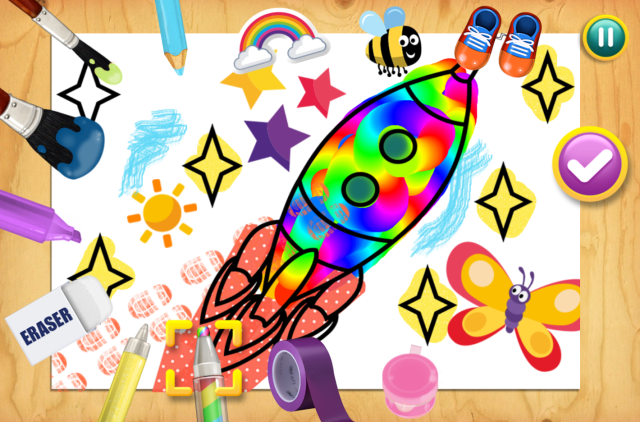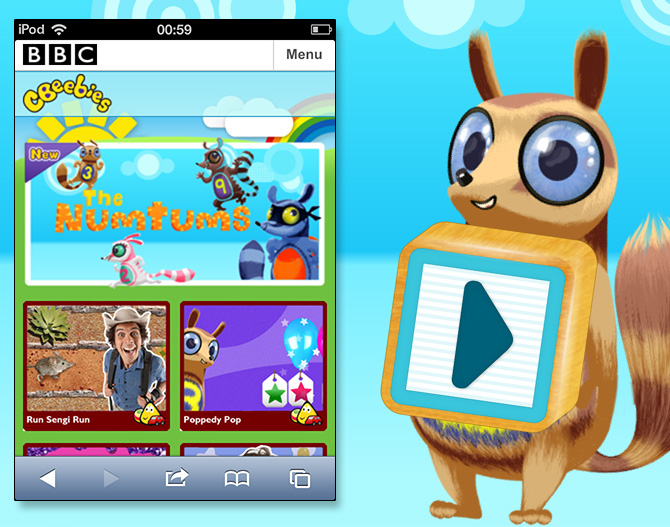Posts Tagged ‘children’
-
How we created the responsive HTML5 Art Tools for the BBC
13th Mar 20154
We were very pleased to be able to create the responsive HTML5 version of the CBeebies Art Tools for the BBC. The CBeebies site had long had a Flash based art tool that allowed children to paint and draw in the browser. The BBC had also released a native app on mobile which offered a similar painting experience on mobiles.
However with the shift of their web site to a responsive layout they required a new art tool – one that was built using HTML5 technologies, that ran across desktop and mobile browsers, and that combined the best elements from both the native app and Flash versions.
Easy to re-skin
One of the primary requirements of the new Art Tool was that it should be easy for their editorial teams to re-skin it. This needed to be possible without having to edit any source code or recompile. To achieve this we built a power JSON data file structure and easy way of managing assets. This allows the BBC to create a brand new re-skin of the Art Tools by simply modifying a single json file and associated graphics. Full sets of PSD templates were created to streamline this process and a comprehensive 80+ page user manual was written for internal staff.
You can see a re-skin of the Art Tools for the show Hey Duggee. As you can see it’s visually quite different from the screen shots above, however it’s all running from the same single code base. Read More
-
Introducing our 3 new HTML5 games for the BBC
26th Oct 2012
It’s always a good feeling when you release a new game. A heady mixture of the elation of having finished combined with the daunting high of knowing that people are now actually playing it. So when you release three games on the same day the feeling should be 3x greater, right? 🙂 That is what happened today when three of our HTML5 games went live on the BBC’s CBeebies mobile web site.
CBeebies is the brand under which the BBC release TV programmes aimed at children aged 6 and under, so from baby and toddlers to pre-school. Supporting the TV shows are a wide range of activities and games on the main web site. But like many organisations they identified the need to offer content to the increasing numbers of visitors hitting the site from mobile and tablet devices.
Working closely with the CBeebies team they selected three popular Flash games from the main site that we rebuilt in HTML5 for the mobile audience. The games included two titles based on The Numtums show: Poppedy Pop and SwipeTum, and one from the Andy’s Wild Adventures series called Run Sengi Run.
-
10 things I took away from The Children’s Media Conference
6th Jul 2010
Last week I attended the Children’s Media Conference with lots of other people from Aardman. It was a 3 day mix of presentations, panels and meeting really interesting people. And everyone there had something to do with the children’s side of the media and entertainment industry. I just wanted to share a few insights that I picked up there. Some are obvious, some less so …
1.) Children are no longer just watching TV, they expect to interact with it. On their phones, via MSN, on YouTube, etc. And often do these things simultaneously (watching a show while chatting to friends about it). The distinction between TV and online is a non-plus for them. They have an extremely rich media diet.
2.) Traditional broadcasters (and “offline” producers) are increasingly worried they are taking too long to resolve the provision of content. And children are just going online instead. The world is changing faster than a lot of them can cope with.
3.) Children prefer “home grown” material – i.e. they don’t want to hear American voices in their cartoons. The same applies to games, only to a much lesser extent.
4.) Broadcasters recognise that the future is on-demand, and in the long term, online. The BBC specifically made a point that they were perfectly aware that digital is the future.
5.) Lots of Children love manga! (no surprise there) The style of artwork allows them to clearly see the emotions that the characters are experiencing. And manga / anime characters do actually show emotion, unlike most US made cartoons in the same area. They find the super powers and stories generally more exciting, and want to be part of that fantasy. There is a really strong “collect, compete, play” association with most popular manga/anime (think Pokemon, Yui Gi Oh or Bakugan). Manga/Anime is less concerned about dealing with emotion and more complex subjects.
6.) “Transmedia” is now what they are calling the latest iteration of “new media”. But it’s all just media really. Transmedia (like before it) is just the means of telling or experiencing a story across multiple platforms.
7.) “Games Bibles” are vital, no matter what scale game you are working on. Matt Costello gave a brilliant (although sadly very brief) talk about how he created the game bibles for games like Doom 3 and Just Cause 2. They should start off as a paragraph, explaining the concept behind the world in which the game lives. And then expand from there, eventually encompassing as much detail as possible in order to bring the game alive. Bibles shouldn’t just focus on the game itself, but look into the backstory and what could happen in the future, should the series run or adapt across to a different media (game made into a TV show or comic for example).
8.) Girl Gamers: Girls love tech! They adopt it way ahead of boys. By 8 years old most of them will own a gaming device (like a DS), by 10 lots will have a mobile phone of their own and a laptop/PC. By 11 they’ll have Facebook accounts (and boys will have XBLA accounts). By 13 most have personal iTunes accounts or equivalent. Between the ages of 9-10 is when most girls peak at their interest of gaming. They are competently using online services (for social and gaming aspects) and use of their mobile is massive. Age 10+ and they mostly now focus on social spaces and social networking. To them Facebook IS a game. Creating private worlds is key, the ability to build a social space away from their home.
9) Games that can tick the following subject boxes appeal strongly to girls aged 10-13: Manipulation (!), Relationships (Sims), Problem Solving (puzzles), Responsibility (pet games), Private Worlds, Role Playing (Imagine Teacher), Identity, Risk Taking. In reality most games fail to keep their long-term interest. A quote from a 10 year old: “I classify my phone and my laptop as my toys”. The Blackberry mobile phone is huge for girls and is often their top “most desired” item. This is due to the social nature / features it provides (Blackberry messenger). Social networking for them becomes obsessive around age 12. By age 13 they want cues from the real world in their games.
10) Graphic Novels and Comics are making a huge come-back for children, and are no longer mostly for adults! Publishers like Walker Books are reporting sales up by 29% over the previous year. They are finally coming “back to kids” – picture books aimed at 8-9 year olds (such as Savage by David Almond) are breaking new ground. Visual literacy is just as important as reading ability. Jamie Smart gave a brilliant talk about how he can release a new comic strip on his web site, and earn a decent living from the merchandise surrounding it. The team at Pulp Theatre are releasing graphic novels through their Alien Ink range, aimed at teenagers and issues they find hard to talk about. Has been a huge success, now sponsored by Channel 4. Again they did the whole range of releasing online and on Facebook before going into print form. They took the comics to where the kids hang out, they didn’t expect them to “come find them”.
Please bear in mind that figures given should be taken in the context in which they were delivered (i.e. are probably only relevant to the UK)
Despite the heat wave it was a great conference. And interesting to see how other people are applying the same kinds of professional skills that we have (from web development to game design) and applying those to entertaining and educating children. Perhaps even yours? 🙂
Hire Us
All about Photon Storm and our
HTML5 game development services
Recent Posts
OurGames
Filter our Content
- ActionScript3
- Art
- Cool Links
- Demoscene
- Flash Game Dev Tips
- Game Development
- Gaming
- Geek Shopping
- HTML5
- In the Media
- Phaser
- Phaser 3
- Projects
Brain Food



